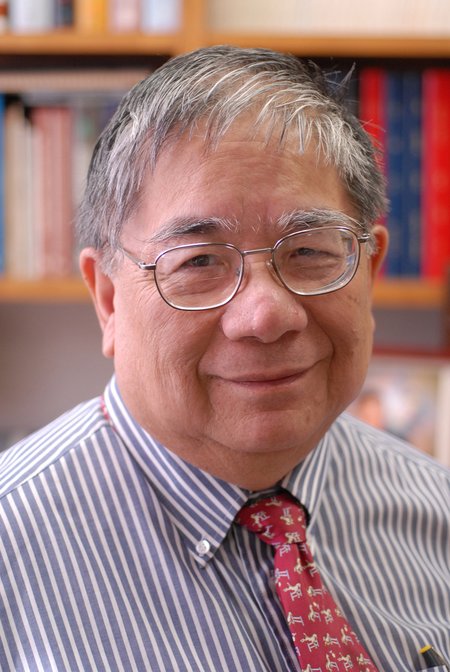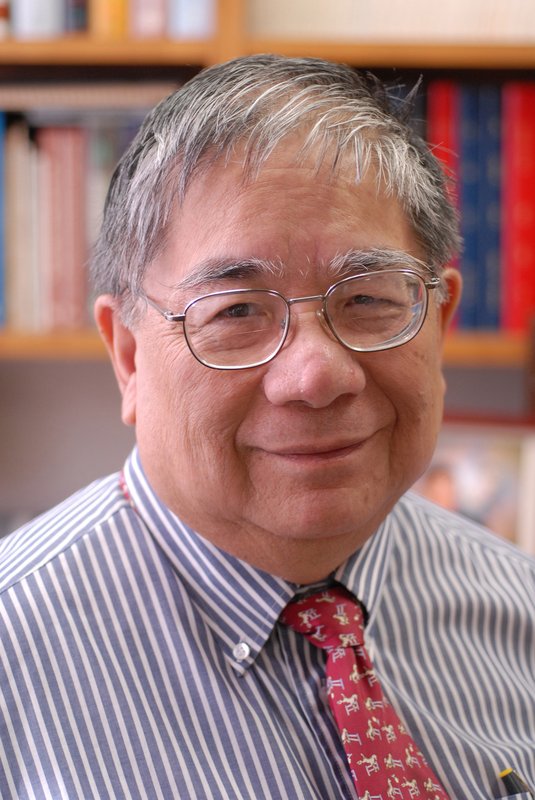Remembering Sunney Chan (1936–2025)
Sunney Chan, Caltech's George Grant Hoag Professor of Biophysical Chemistry, Emeritus, died on May 5. He was 88 years old.
Chan rose from humble beginnings to become an eminent biophysical chemist at Caltech and later in Taiwan. He pushed the boundaries of investigating biological molecules with a technique known as nuclear magnetic resonance (NMR). Chan was widely recognized as an outstanding teacher and mentor who was active on campus not only in leadership positions within the Division of Chemistry and Chemical Engineering and the Institute but also in supporting Caltech students.
Indeed, during his time at Caltech, Chan was honored with Caltech's ASCIT (Associated Students of the California Institute of Technology) Teaching Award in 1991, the Richard M. Badger Teaching Prize in 1994, and he served as Master of Student Houses from 1980 to 1983. Chan was twice appointed executive officer for chemistry (from 1978 to 1980 and again from 1989 to 1994) and served as chair of the faculty from 1987 to 1989.
"Sunney embodied the principles that teaching and research are inseparable, and that service is an essential part of the profession," says Doug Rees, the Roscoe Gilkey Dickinson Professor of Chemistry and a Howard Hughes Medical institute Investigator. "For those of us who followed in his footsteps as executive officers of chemistry, Sunney was the model. He was an inspiring mentor and leaves a legacy of former students and postdocs all the more remarkable for the diversity of their subsequent careers and interests."
"Sunney Chan was an outstanding biophysical chemist, using magnetic resonance methods to help decipher the structures and reactions of complex membrane-bound metalloproteins," says Jacqueline Barton, Caltech's John G. Kirkwood and Arthur A. Noyes Professor of Chemistry, Emerita. "But Sunney was also an important member of Caltech because of his service to the Caltech community, focusing particularly on the Caltech undergraduates."
Chan was born in San Francisco on October 5, 1936, to immigrant parents who worked in a factory manufacturing denim for Levi Strauss & Co. He spent his early childhood in what he described as a "Chinatown ghetto community." "There was not a drop of academic blood in my body," he wrote in the Annual Review of Biophysics in 2009. "There were no role models, scholars, scientists, or professionals for me to emulate. I was the first in my family to attend university, receive a college degree, and obtain a PhD."
At age 12, Chan's parents sent him to middle school in Hong Kong, concerned that he was growing up as a "'hollow bamboo,' without any knowledge or appreciation of my Chinese heritage or culture," Chan wrote in the 2009 review article. After his first term, he transferred to an English-speaking school in Hong Kong run by Irish Jesuits. There, Chan first became interested in mathematics and science, inspired by the excellent teachers at the school.
Upon completing high school, Chan returned to the United States and enrolled at the University of San Francisco (USF), intending to join the priesthood and become a science teacher. Before long, however, he discarded the idea of becoming a Jesuit priest, and with the help of faculty at USF, he transferred to UC Berkeley where he completed his BS in chemical engineering in 1957 and his PhD in physical chemistry in 1961. His thesis was a study of the molecular structure of oxetane (trimethylene oxide). Microwave data showed a planar molecule, but far-infrared spectroscopy showed a bent ring. Chan's task, in which he was successful, was to reconcile these two types of data.
At UC Berkeley, Chan planned to pursue a career in industry, but his PhD mentor insisted that he apply for a postdoc in the lab of Harvard physicist Norman Ramsey. It was at Harvard that Chan began working with NMR, a tool that he would use throughout his career.
NMR is a non-invasive method that exploits the magnetic properties of atomic nuclei to reveal valuable chemical information. When certain nuclei, such as hydrogen or nitrogen, are placed in a magnetic field, they absorb and re-emit electromagnetic radiation at characteristic frequencies. These signals can provide insights into the local environment of the nitrogen, carbon, and hydrogen atoms in molecules such as nucleic acids and proteins, allowing scientists to deduce their structures and compositions in solution and under dynamic conditions.
When Chan completed his postdoc in 1961, he was hired as an assistant professor at UC Riverside. It was here, Chan said in 2009, that his "original interest in science teaching was finally beginning to take shape." Intent on mentoring his students through the process of scientific discovery, he gained access to an NMR spectrometer and took charge of its operation in the department.
It was also in 1961 that Chan was invited to give a lecture at Caltech. Within a week, the Institute offered him a job, which Chan declined. "As my research program was just about to gel, I did not feel it was time for me to make a move," Chan remembered. "I was also reluctant to move to such a high-power place." But upon further reflection, he decided to opt for Caltech's "stimulating research environment and high-quality students." It was a decision Chan never regretted, saying in 2009, "It is simply a classy institution. I have been associated with Caltech for well over 45 years. Not for a single moment have I ever regretted the decision I made in 1961."
By the late 1960s, Chan turned toward the field of biophysics. "Given that I … had no formal training in biochemistry or biology, I was entering the field with a handicap," Chan remembered. But it turned out that Chan's experience with spectroscopic tools and physics prepared him well for formulating interesting experiments on biological molecules, with a particular focus on membranes and membrane proteins. He reported the first use of high-resolution NMR to elucidate the stacking of nucleic acid bases in aqueous solution, and in characterizing the dynamics of lipids in membranes. From this interest in membranes, Chan moved into membrane proteins with a series of biochemical and spectroscopic studies probing the structures of metal ion sites in cytochrome oxidase, the terminal enzyme in the respiratory chain, and on blue copper electron transfer proteins.
"Sunney made major contributions to biological inorganic chemistry," says Harry Gray, the Arnold O. Beckman Professor of Chemistry at Caltech.
Chan subsequently turned his attention to the structure and mechanism of particulate methane monooxygenase, a complex copper-containing membrane protein, with the goal of developing a more efficient catalyst for the conversion of methane to methanol.
Chan was also an engaged and supportive colleague. Dennis Dougherty, the George Grant Hoag Professor of Chemistry, recalls the support Chan gave him early in his career, providing him unlimited access to a spectrometer in his lab. "That, along with the intellectual advice and support that he gave me, really enabled me to get my research program off and running," Dougherty says. "Sunney was always a steadying influence and a valued colleague to all of us in the Division of Chemistry and Chemical Engineering at Caltech."
In 1997, Chan retired from Caltech and moved to Academia Sinica in Taiwan, where he created a research center for genomics and modernized the curriculum in chemistry. Though principally an administrator there—first as director of the Institute of Chemistry and then as vice president of the institute—Chan continued to pursue his research in converting methane to methanol and understanding protein folding in water. He received emeritus status from Caltech in 2002.
Throughout his career, Chan received numerous honors and awards, beginning with a Guggenheim Fellowship in 1968. He was named a member of the American Physical Society in 1987, the American Association for the Advancement of Science in 1992, the Academy of Sciences for the Developing World and the Biophysical Society in 2004, the American Academy of Arts and Sciences in 2010, and the International Academy of Physical Sciences in 2011. In 2004, Chan was awarded the William C. Rose Award by the American Society for Biochemistry and Molecular Biology for "outstanding contributions to biochemical and molecular biological research and a demonstrated commitment to the training of younger scientists." In 2021, he received the Presidential Science Award in Taiwan.
To honor Chan for his service at Academia Sinica, a lecture series was established in his name. The lecture website says of Chan, "He has been particularly inspirational to young scientists, and the generosity, with which he has shared his chemistry, insights about science, wisdom on life, and his knowledge about wine, food, gourmet dining, and restaurants, is well known throughout the community here."
In 2009, Chan reflected that he "learned much" from his many (more than 200 at that time) students, postdocs, and colleagues. "Many of my former students and postdocs have gone on to do new science and even open new areas of research," he wrote. "I am proud of them. But that's the way it should be. In retrospect, I like to think that my style of training students works. The most important part of doing science is asking questions, and I taught my students to ask questions and how to ask questions. Without questions, good or bad ones, there is no problem to solve."
Chan is survived by his wife of 60 years, Irene; his sisters Elizabeth Gong and Diane Chan; son, Michael Chan (currently a professor of life sciences at the Chinese University of Hong Kong); daughter-in-law, Marianne Lee; and grandsons Peter Chan and Nicholas Chan.
A viewing and symposium in Chan's honor were held in Taiwan. A service and burial followed in San Francisco. Additionally, the Institute of Chemistry, Academia Sinica, will launch a permanent website to commemorate Chan. Contributions can be submitted here.
 Sunney Chan
Sunney Chan

